Winter legumes are important in forage production in Florida. They are frost tolerant and can supply highly nutritious feed during the winter and spring months. When properly inoculated, they supply nitrogen for their own growth and provide nitrogen for other plants growing with or following them.
Site/Soil Selection and Seedbed Preparation
Select sites that are naturally moist during most of the year but not likely to be flooded for extensive periods. Clovers require an abundant and constant supply of moisture. When possible, select soils with above average clay and organic matter content because they usually have a greater water-holding capacity. Consider possibilities of moisture control (both irrigation and drainage) in selecting the sites.
Old, permanent grass pastures may be renovated by plowing in the fall and planting a mixture of clover and an annual grass. Plowing and planting should be done on the same day to conserve moisture. If native land is selected as the site for planting, it should be cleared of unwanted trees, stumps, dense underbrush, and other undesirable vegetation prior to actual seedbed preparation. Several diskings may be required to properly prepare a seedbed for planting.
It is often desirable to seed clovers into an established grass sod. In such cases, it is not necessary to completely destroy the sod. It should be grazed or mowed closely to remove excess forage. If the sod is bahiagrass, it should be cut with a medium- to light-weight disk or chopper before seeding. The purpose of this cultivation is to reduce competition from the bahiagrass and expose soil so that seed can come in direct contact with it when planted. Another approach is to use a no-till drill and seed directly into the existing sod.
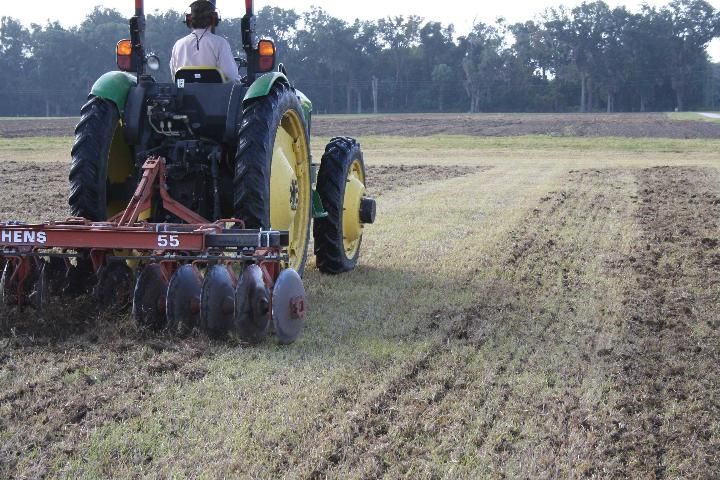
Credit: Yoana Newman
Liming
Have soil tested at least two, preferably six, months before planting. Broadcast the recommended kind and amount of limestone 2 to 6 months before seeding clover and incorporate it with the soil during seedbed preparation. Most soils in Florida used for clovers will require liming. A suitable pH range for sweetclover and alfalfa is 6.5 to 7.0. Other winter legumes will require a pH above 6.0.
Types and Cultivars
Several clovers and other legumes can be used in Florida. They are described in the sections that follow.
White Clover
White clover is the most widely adapted forage legume in the state. It requires a continuous and abundant supply of moisture and will tolerate flooding for short periods. It can be grown in combination with most grasses if management is such that grass is not permitted to seriously compete with the clover. Osceola and Regal are recommended ladino-types, and Ocoee, Durana, Regal Graze, and Louisiana S-1 are recommended intermediate types. All varieties mentioned may live from year to year if moisture and fertility conditions are favorable, but Osceola is the most persistent. Seedling white clover may not be ready for grazing until mid-February or early March, but "live-over stands" may be ready 4 to 6 weeks earlier. Seeding rate for these varieties is 3 to 4 lb/A.
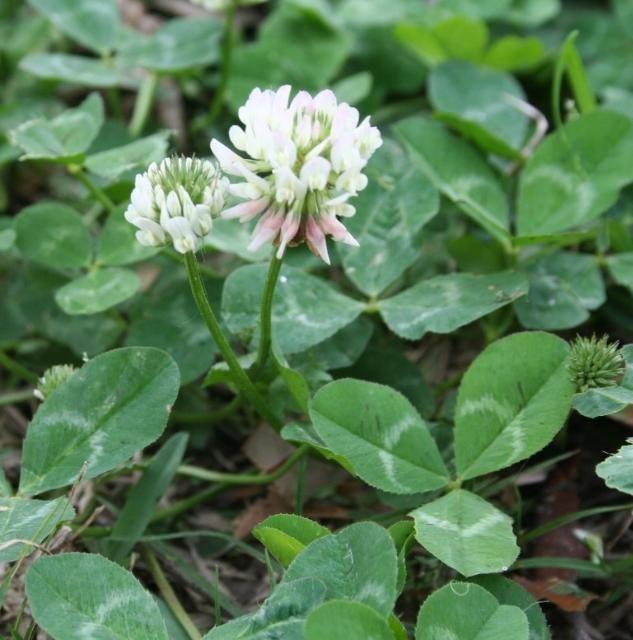
Credit: Yoana Newman
Crimson Clover
Widely grown on the well-drained sandy loams, crimson clover does poorly on deep dry sands and will not tolerate flooding. It has an earlier and shorter grazing season than white clover. Crimson clover is well suited for planting in combination with annual winter grasses. It is a good seed producer and can be managed for natural reseeding. A suggested cultivar, which is a reseeding type, is Dixie. Other newer cultivars of crimson clover have been developed and are suitable for use in Florida, but seed supplies have often been difficult to obtain. Seeding rate should be 20 to 25 lb/A.

Credit: Yoana Newman
Berseem Clover
This annual legume is a fast-growing legume with low bloat potential that requires good soil moisture conditions and tolerates temporary flooding (4-5 days). It will not grow well under droughty conditions. It is adapted to areas with mild winters such as central Florida, but it is not cold tolerant. Temperatures of 25 degrees and below will kill the plant. Varieties for Florida include Bigbee and CW 9092. Seeding rate is 15 to 20 lb/A. It can be planted in a prepared seedbed or overseeded into a warm-season perennial that is dormant and has been closely grazed or clipped.
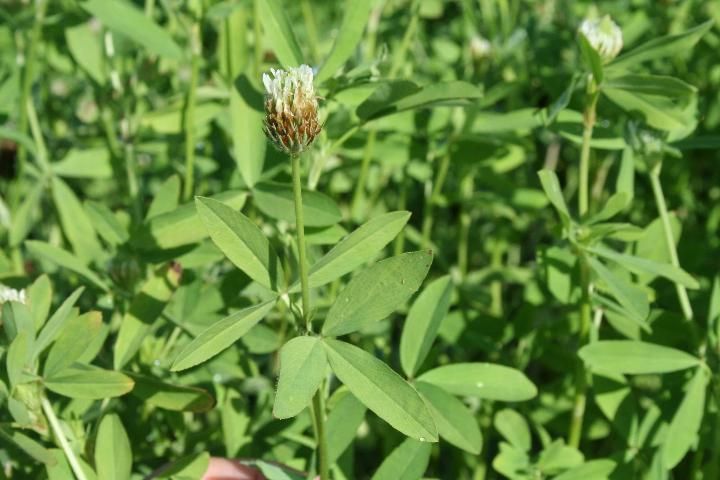
Credit: Yoana Newman

Credit: Yoana Newman
Red Clover
Red clover has soil requirements quite similar to those of white clover but is more easily damaged by excess water. Accumulated growth may be damaged by powdery mildew, which can be controlled by grazing or cutting for hay. Although natural reseeding may occur, especially in northwestern Florida, it does not seed abundantly under Florida conditions and acts mainly as an annual. Red clover has potential as a hay crop and for round bale haylage—particularly in combination with winter cereal grasses such as oat. Varieties suggested for Florida are Southern Belle, Barduro, Kenland, and Redland Max. Southern Belle and Barduro, developed in Florida, have been more productive in research trials than other cultivars, especially at early season harvest. Seeding rate is 12 to 15 lb/A.
Arrowleaf Clover
Arrowleaf clover is adapted to the well-drained, clay or clay-loam soils in northwestern Florida. It also grows on some soils that are too wet for crimson. Recommended cultivars are Yuchi and Apache. Arrowleaf clover matures much later than crimson clover, providing grazing through May. It tends to decrease in productivity due to disease buildup if replanted in the same location more than 2 or 3 years. Seeding rate is 5 to 8 lb/A.
Alfalfa
In recent years, some growers have had good success with alfalfa on moderately- to well-drained sites. It requires more management than clovers, including K and P fertilization after every harvest and favorable moisture conditions. Excellent hay can be made from this plant, but the high humidity in Florida makes drying difficult. Harvesting and storing alfalfa as haylage or silage eliminates some of the weather problems that are associated with making hay and has been produced successfully in central and north Florida. Seed of the old cultivar Florida 77 and Florida 99 are no longer marketed. On a commercial scale non-dormant Bulldog 805 has performed well overseeded into bermudagrass pastures for several years, and Alfagraze Round Up Ready (RR 600) has shown good yields and adaptation during the first year of establishment in central Florida. In variety trials new, non-dormant cultivars Ameristand 901 and Bulldog 805 have shown good yields in variety experiments. Further testing for adaptation is currently on-going. Alfalfa usually acts like an annual, especially when planted on flatwoods sites in southern Florida, which become waterlogged during periods of heavy rainfall. Improved cultivars, when available, may live for 2-3 years when planted on highly productive sites in central and north Florida. Seeding rate is 12 to 20 lb/A.
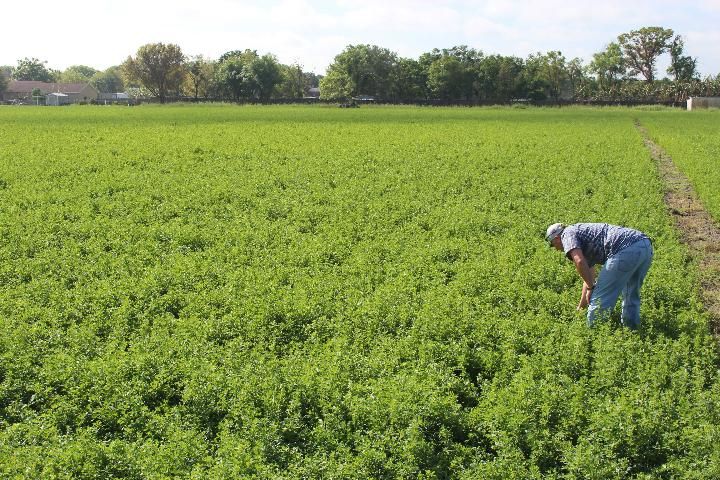
Credit: Yoana Newman
Sweetclover
Annual, white sweetclover will grow on slightly drier soils than white clover, but will not tolerate flooding. It is not as palatable as some other clovers, but cattle learn to eat it, and it provides excellent quality forage. Varieties recommended are Floranna and Hubam. Sweetclover produces seed, but should be replanted each year. Seeding rate is 12 to 15 lb/A.
Inoculation of Seed
Clovers and other legumes have the ability to take N from the air and fix it into the plant if certain bacteria are in the soil where the plant is growing. When these organisms are present, nodules develop on the roots and the legumes accumulate N for their growth. The bacteria required by the legumes discussed in this publication are not ordinarily found in Florida soils.
Not all legumes use the same bacteria for the N-fixing process. The N-fixing bacteria are divided into several groups, and care must be taken to secure the correct one for the legume to be planted.
These bacteria can be introduced into the soil by inoculating seed with commercially prepared cultures. Directions given on each container of the inoculant should be followed closely. Inoculated seed should be planted at once and not exposed to direct sunlight or allowed to become heated or dry.
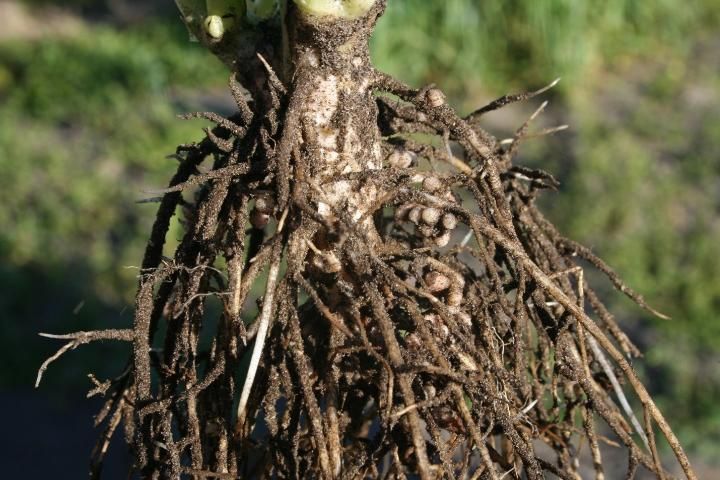
Credit: Yoana Newman

Credit: Jose Dubeux
Planting
Plant legumes on a well-prepared seedbed from October 1 through mid-November when cooler temperatures prevail (see Site/Soil Selection and Seedbed Preparation). The soils should be thoroughly moist at the time of seeding. Seed should be planted with a cultipacker-type seeder, drill, or other appropriate seeding device, and given very shallow coverage. Packing is important; it gives a smooth, firm seedbed, presses seed into the soil, and usually gives all the coverage necessary.
Pasture drills (sod seeders, grain drills) can be used to seed directly into an undisturbed sod. The grass should be mowed, burned, or grazed closely prior to seeding. Bahiagrass sods will need to be disked prior to seeding. For broadcast seedings, harrow lightly all grass sods either before or after seeding in order to bring the seed in direct contact with the soil.
It may be desirable to plant legumes with small grains and/or ryegrass. This practice increases the total tonnage of forage produced, lengthens the period of production, and reduces bloat problems. Successful mixtures include small grains (cereal rye), ryegrass, crimson, and arrowleaf or red clover. Ryegrass and white clover can also be grown together.
Fertilization
Soil tests will indicate the kinds and amounts of fertilizer required. Plantings on virgin land or where fertilizers have not been applied for several years may require relatively high amounts of phosphorus (P) and potassium (K). Where clovers or other well-fertilized crops have been grown for several years, the amount of P and K required may be reduced. A supplemental application of K in late spring may be needed on sandy soils.
Micronutrients are usually sufficient in most Florida soils for maximum plant growth, especially on land where micronutrients have been added in the past. The producer should consider how much increase in yield will be needed to equal in value the cost of added micronutrients. Micronutrients, particularly copper, manganese, zinc, boron, and possibly other elements, may be needed on virgin land. Boron should routinely be used where alfalfa is planted.
Sulfur is a necessary plant nutrient that is usually supplied in superphosphate and other fertilizer materials. If sulfur-free materials, such as rock phosphate or triple-superphosphate are used, sulfur may need to be added on certain soils. If growth of the clover is poor when other important growth factors have been met, especially soil moisture and correct pH, then the producer might add sulfur to a small area to see if he can get a response. If a growth response occurs, then the entire field can be treated.
"Live-over" and reseeding stands should be refertilized, on the basis of soil-test results, in late fall and in some cases in late winter or early spring.
Irrigation
Rainfall distribution in Florida is such that drought is a limiting factor in clover production about 2 out of 3 years, unless provision is made for irrigation. Consideration should be given to the suitability of an area for irrigation when selecting a site for planting clover. Installation and operation of an irrigation system is an expensive item, hence it should be considered only in intensive forage production and management programs in which highly productive plant species like alfalfa are grown and adequate fertility levels are maintained.
Management and Utilization
Legume pastures require intensive management if the full potential value is to be realized. Grazing of most varieties should be delayed until a plant height of over 3" is achieved. This is usually 2-1/2 to 3 months after germination. Rotational grazing with several pasture divisions, each grazed for a short interval and with enough cattle to permit some seed production while being grazed, is one of the most efficient methods of using clover pasture. This will allow clovers to set seeds and reseed in the following season. Other methods used include limit grazing and creep grazing. Limit grazing is where cattle are given access to legume pastures for only a few hours each day to supplement their protein and energy requirements. Limit grazing is especially useful for cattle that are being rebred. Creep grazing has been utilized productively by some ranchers. Ideally, a small intensively managed pasture would be located centrally to larger grass pastures. Access to the small pasture is restricted to only the calves and provides a much needed supplement to them.
Legumes have an extremely high moisture content in the early stages of growth and can cause bloat when dry roughage is not available to animals.
Alfalfa has been used primarily as a hay or haylage crop in Florida, but has also been pelleted and could be grazed under intensive management. Red, crimson, and arrowleaf clover have also been successfully used as hay crops.
For additional information on Forages, please visit the Forages of Florida website at http://agronomy.ifas.ufl.edu/Forages of Florida.
Grazing management during the spring-summer transition is key to persistence of warm-season perennials. During the spring, warm-season perennials start to emerge from their cool-season dormancy. If you overseeded your pastures with cool-season forages, you need to attempt for the competition that happens during this transient time. The spring is one of the prime times for annual ryegrass and clover growth. It is a good practice to stock the pastures and graze off the cool-season annuals by the end of March/early April to help reducing the competition for the warm-season perennials to emerge. Thick stands of clover and annual ryegrass increases competition with warm-season perennials and might hurt their stand. Increasing the grazing pressure during late March/early April allows warm-season perennials to compete with cool-season annuals. Reducing competition when warm-season perennials are emerging, improves their persistence. After their emergence, lenient grazing pressure until warm-season perennials have enough leaf area will help to sustain the growth during the season. Do not lose the summer grazing season in the first month!